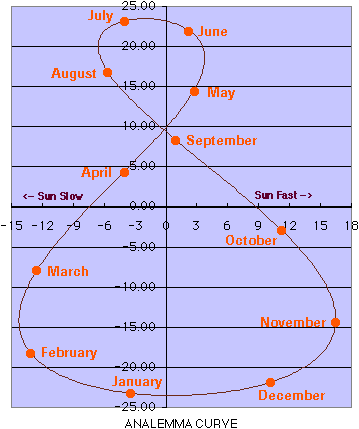Introduction
All days do not contain the same number of minutes. Speed does not always equal rate divided by time. Time can depend upon direction, as a vector; however, it is used as a scalar. With so many inconsistencies, is time really a reasonable quantity for accurately describing physical phenomenae?
The answers to these, and many other puzzling questions, lie in revolutionary discoveries by Howard Lawrence Schriefer in pursuit of a Unified Theory of the universe.

Logic
Notice the analemma, shown at left, as on a globe of earth. It's the figure-eight-shaped legend which indicates for a given date, how many minutes more or less than 24 hours the earth's rotation is. That's right, only four days of the year contain exactly 24 hours. viz., April, 16; June, 14; September 2; and, December, 25. All the other days contain more or les minutes than the 1440 minutes it takes to make 24 hours.
All other days differ from twenty-four hours by anywhere from about 16 minutes less to 14 minutes more. The actual variation of length of days is given by the Equation of Time, which can be computed. For convenience and simplicity, society including scientists, adopted an artificial system of time wherein every day is said to have exactly 24 hours.
Traveling 1042mph at the equator from west to east keeps one neck-and-neck with the sun. Traveling 1042 mph at latitude 39° from west to east for one hour puts one way ahead of the sun, about 232 miles into the next time zone. Or, was it an hour, since the time zone was used up and then some? Notice some complexity in the "simple" rule that speed equals distance divided by time?
Time, on earth, also appears to depend upon direction, because the speed of rotation of the earth needs to be added when traveling west to east and subtracted when traveling east to west. A time zone of one hour on earth is 15° of longitude, or roughly 1042 miles at the equator. The number of miles between time zones decreases from the equator toward the poles of earth. At latitude 40°, say near Denver, CO, the time zone is approximately 798 miles long. Halfway across this time zone, or 399 miles represents a half hour. About two hundred miles represents about 15 minutes. Subdividing the time zone into football field lengths of 300 feet requires 14045 subdivisions of the time zone; or, 1/4 of a second difference from one end of the football field to the other. That is, if the football field is laid out east-west. The difference in time from one side of the field to the other is very close to zero seconds. So, time depends upon direction?
Wait, it gets even better. Say you are sitting at the fifty yard line. A runner is at each goal line. The east goal line is a quarter second away from the west goal line. The runners start at your given signal, and sprint toward opposite goals at the same "speed", and check the stopwatches at the end. The east-to-west runner reads his time less 1/4 second. The west-to-east runner reads his time plus 1/4 second. They both ran the same "speed", but their times are 1/2 second apart. Did they pass each other exactly at the fifty yard line? Suppose they ran the same "speed" at Bangor, ME or at Brownsville, TX? What effect does all this have on radar guns and speed limits at different latitudes and longitudes? Bottom line is, we don't know what "speed" means, even though it is based upon distance and time. Since distance is a basic tangible quantity for science, how reliable is the quantity known as "time?"
Equation of Time
With such inconsistencies in time associated with direction and location variability, it is too inconsistent for use as an independent variable in the design of such devices as altimeters and heart monitors. What was Einstein thinking about when he claimed that mass and length change with "speed", when "speed" is so interwoven with time? Why does science predict changes in tangible quantities such as mass and length (matter and space), while maintaining a fabricated man-made definition, "time", as all-controlling and absolute?
Caution
Since time is defined as a quantity of absolutely equal increments, which have been shown to be directionally dependent, it is improper to apply it to the irregular phases of a three-dimensional universe as a scalar quantity. Perhaps instead of a quantity such as "time", we should use the inverse of a standard universal frequency, unrelated to the misinterpretations of "time" which have been artificially assimilated into our cultures. Thus, time would be a real and scalar quantity, not subject to dilation.

